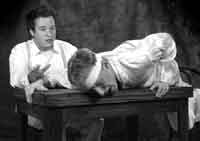Rhinoceros: A roaring ride
Theatre department's last show of semester to run through Saturday
By EISA AL NASHMI

Jean, played by Blake Ellis (right), goes through various stages of turning into a rhinoceros in the theatre department’s production of “Rhinocerous,” which runs through this week, while Berenger, played by Brandon Petrie wonders what is happening to his best friend. Photos courtesy of theatre department |
In a conventional European town, all but one person abandon being humans with rational minds and choose to be monster-like creatures like rhinoceroses.
It becomes the new thing to do in the town.
A packed audience saw how people choose conformity over their individual identity for the sake of fitting in society on Friday’s opening night of Rhinoceros, the last University Theatre production of this semester.
The show will continue its run this week.
Brad Myers, director of the play, said Rhinoceros portrays the theater of the absurd, which suggests that there is no meaning in life, that people are born and will eventually die.
“Absurdist playwrites believe that all values in life are randomly selected to make meaning of living,” Myers said.
According to an essay from www.untitledtheatre.com, the author of Rhinoceros, Eugene Ionesco, wrote this play to refute Nazism. He was inspired by the journal entries of a man who was forced to a Nazi rally attended by Hitler. The man’s conclusion was “I am alone and they are all together.”
Myers said turning into rhinoceroses may sound humorous at first, but this play gets darker and darker until it becomes scary.
“I want the audience to be entertained and terrified at the same time,” Myers said.
Melissa Geston said the play displayed society in a very interesting way.
“The play showed how people always conform and choose to be followers instead of leaders,” Geston said.
Animal studies student Anne Schroeder said the play was “very powerful.”
“The show’s connection with World War II and Nazism really impacted me,” she said.
Anita Stover said even though the play potrays Nazism, she can contrast it to today’s society.
“It’s all about wars and how people choose sides,” Stover said.
Myers said the play resembles a unique and an unrealistic style that is beyond what the student actors have experienced.
“The acting style stretches their imagination and is a good workout for them.” Myers said.
For Brandon Petrie, who plays the role of Berenger, the play is “the funniest thing in the world with the saddest thing you have ever seen.”
Petrie said people would call his character a “drunken slob,” but for Berenger, drinking is way for him to fit in to society.
“Berenger is desperately seeking meaning of life in a world that offers none,” he said.
While the whole town chooses to live as animals, Berenger refuses to conform at the expense of his human individuality. He didn’t fit in society when the people were humans, so he didn’t think he would be accepted even if he turned into an animal as everyone else.
“For Berenger, it is ridiculous to define yourself with the newest popular thing,” Petrie said.
Blake Ellis said his character, Jean, is a well-groomed charming man. “He is what people in society strive to be,” he said.
But when his character slowly turns into a rhinoceros, Ellis said Jean’s personality shifts to the exact opposite—he becomes aggressive with unstable emotions.
Ellis said the transformation from a human to rhinoceros is not direct. Rather, it is a gradual change where the rhinoceros takes over the brain and slowly moves in until it controls the whole body.
“It’s really difficult to play that transition,” Ellis said. “I play human for a minute, then play different levels of a rhinoceros in another.”
To prepare for his role, Ellis said he and the cast went on a field trip to the San Francisco Zoo, where they observed rhinoceroses’ movements, sounds and facial expressions.
“I tried to incorporate what I learned into my body and voice until I created a bizarre physical manifestation of a rhinoceros,” he said.
For costume designer Caroline Mercier, creating the rhinoceros look was quite a challenge.
“The idea was to create a blend between a human and an animal,” Mercier said. “I wanted to suggest the scope of a rhinoceros, but I also wanted the look to be more absurd and theatrical.”
Using plaster casts of the actor’s heads, Mercier created fitted rhinoceros masks for each actor. The 24 masks were made out of liquid latex, a rubbery paste.
Mercier said, “every rhinoceros looks different depending on the maturity level and personality.”
In the first stages of being a rhinoceros, the masks had tiny horns. As they mature, the masks had longer or more horns, eyes or ears added and hair attached.
Rhinoceros will run Tuesday through Saturday in the John Wright Theatre in the Speech Arts Building.
Tickets are $7 for students, $12 for faculty and staff and $14 for the general public.
|

